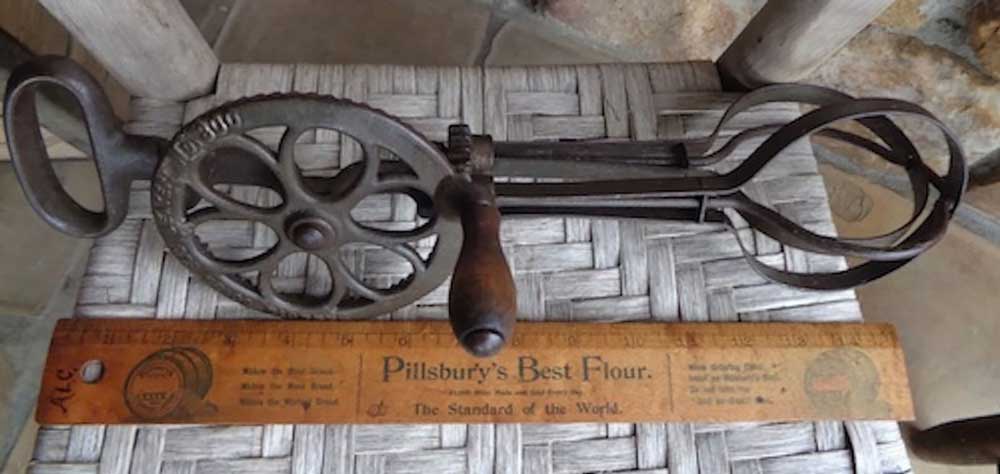July 2024
Good Eye
The Beat(er) Goes on
by Peggy Whiteneck
While they’re less often used today, most readers will be familiar with egg beaters – items with a top handle and hand crank above a pair (usually) of beaters that rotate when the hand crank is turned. The first of these appeared as early as the 1850s. The earliest examples were made in the United States and in England. An early design by Dover Stamping Co. in the US was issued in 1859.
There was no standard design for these beaters, and makers experimented with a variety of forms. Most were made as independent tools to be used with a bowl of the cook’s choice, but there were also versions that were attached to a glass or metal container to hold the contents during mixing. Some were even attached to table or counter clamps similar to those used for meat grinders (“Early Rotary Egg Beaters,” Home Things Past, homethingspast.com/2012/02/19/antique-egg-beaters). Of this latter style, one 1875 housewife commented, “Ah! and what a silly was meself…to be thinking it was a coffee-mill, when I saw you a-screwin’ it on to the table!” (https://www.victorianpassage.com/2008/11/the_dawn_of_the_egg_beater/).
My mom collected old egg beaters of various forms and delighted in finding new versions. The handheld types were made in so many different forms that she had an old wooden barrel full of them. I confess it’s surprising to me that an item so relatively simple to use was made in so many different forms, the inventors of which each insisted that theirs was best.
Whisks – simple handles with non-mechanical mixing wires attached – were also popular and were used to whip lighter items such as liquids and eggs while beaters were generally used for thicker challenges such as batters or frostings. The beaters were especially useful in whipping up egg whites to make meringue, a process that, before the advent of the egg beater, took as much as 90 minutes by hand! By the 1870s, the Dover cast-iron rotary beater reduced that time for beating egg whites to a froth to just 5 minutes. Between 1903 and 1908, Clarence Taplin made a beater that he claimed was an improvement in ease of use, strength, durability – probably in no small part because it was made of a metal that wasn’t cast iron! (Terry Kerston, “The Labor-Saving Rotary Egg Beater,” Lacrosse County Historical Society from the Lacrosse Tribune, Sept. 17, 2016).
Egg beaters were made in so many different forms by so many manufacturers that they could be purchased for as little as 10 cents apiece – albeit a dime meant a lot more in the late 19th and early 20th century than it does today. When my mom was collecting in the 1970s and ‘80s, she could pick them up in antique stores and second-hand shops for less than $5 apiece. Today, depending on age and condition, each can sell anywhere from about $20 to $50 or more; at the higher end, we’re talking hundreds of dollars. Still, there were so many beaters made in so many different forms that you shouldn’t be surprised to find some much cheaper at your local antique mall. Be aware also that egg beaters have been made right up to the present day, so not all of them are antiques.

Late 19th-century cast-iron egg beater
This huge, late 19th-century cast-iron egg beater made by the Taplin Manufacturing Co. was marked “MAMMOTH DOVER EGG BEATER NO. 300″ on the turning wheel. Very early in the development of egg beaters, the name “Dover,” the manufacturer of some of the earliest models, had become generic to describe the tool itself. It sold on eBay in June for $85. Another example of an egg beater actually marked as being made by Dover Stam. & Manufacturing Co. and three patent dates for 1873, 1888, and 1889, sold that same month on eBay, also for $85. Many other old egg beaters sold for a lot less on eBay – but a few sold for a lot more. Image courtesy of the author
Egg beaters and whisks are used less often these days than in the late 19th and early 20th centuries. Modern cooks might use a simple fork to whisk eggs for scrambling and an electric mixer for cakes and other heavier batter. (Not to mention just using their hands for mixing and kneading heavy dough on pie crests or breads!) “Still,” as Terry Kerston notes in the article cited above, “in spite of the ease of an electric mixer, it’s worth noting that Taplin’s durable rotary eggbeater is more than 100 years old and works as well as ever. Can the same be said of any modern electric handmixer?”
Well, Kerston’s got me there!
Peggy Whiteneck is a writer, collector, and dealer living in East Randolph, VT. If you would like to suggest a subject that she can address in her column, email her at allwritealready2000@gmail.com.

